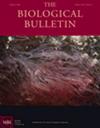三瘤梭子蟹细胞色素P450环氧化酶(CYP15)的分子特征及其在法诺糖酸甲酯代谢中的作用
IF 1.9
4区 生物学
Q2 BIOLOGY
引用次数: 4
摘要
CYP15编码微粒体细胞色素P450酶,可能参与昆虫幼体激素的生物合成。本研究从梭子蟹(Portunus trituberculatus)中克隆了CYP15的全长cDNA。这个PtCYP15氨基酸序列包含6个保守结构域,这是细胞色素P450家族的典型特征。系统进化树分析结果显示,PtCYP15聚集在一个甲壳类物种分支中,表明CYP15可能在甲壳类动物中存在更广泛。PtCYP15 mRNA在三管蟹中具有广泛的组织表达模式,包括在两性肝胰腺和雌性蟹的卵巢中高水平表达。在卵巢发育阶段,PtCYP15 mRNA在雌蟹的肝胰腺和卵巢中在I期和II期高表达,在III期和IV期低表达。这些表达谱与血淋巴中法脂酸甲酯的表达谱相反,提示PtCYP15可能参与法脂酸甲酯的代谢。体外研究表明,只有法糖酸甲酯能上调肝胰腺中卵黄原蛋白的表达,这表明法糖酸甲酯可能相当于甲壳类动物的幼体激素III。法脂酸甲酯处理增加了肝胰腺和卵巢外植体PtCYP15的水平,而幼激素III处理降低了卵巢外植体PtCYP15 mRNA的水平,提示PtCYP15可能参与了法脂酸甲酯的降解。此外,在卵巢外植体中添加幼激素III可抑制PtCYP15 mRNA的表达水平。这些发现为进一步研究甲壳类动物的法诺酸甲酯代谢提供了基础信息。本文章由计算机程序翻译,如有差异,请以英文原文为准。
Molecular Characterization of the Cytochrome P450 Epoxidase (CYP15) in the Swimming Crab Portunus trituberculatus and Its Putative Roles in Methyl Farnesoate Metabolism
CYP15, which encodes a microsomal cytochrome P450 enzyme, could be involved in juvenile hormone biosynthesis in insects. In this study, a full-length cDNA of CYP15 was cloned from the swimming crab Portunus trituberculatus. This PtCYP15 amino acid sequence contains six conserved domains, which is a typical feature of the cytochrome P450 family. Phylogenetic tree analysis results showed that PtCYP15 clusters in a single branch of crustacean species, suggesting that CYP15 may be more widely present in crustaceans. The PtCYP15 mRNA has a broad pattern of tissue expression in P. trituberculatus, including high levels of expression in the hepatopancreas of both sexes and in the ovary of female crabs. During ovarian development stages, PtCYP15 mRNA is highly expressed in stages I and II and less so in stages III and IV in the hepatopancreas and the ovary of the female crabs. These expression profiles are opposite those of methyl farnesoate in hemolymph, suggesting that PtCYP15 might be involved in methyl farnesoate metabolism. In vitro studies show that only methyl farnesoate upregulated vitellogenin expression in the hepatopancreas, suggesting that methyl farnesoate might be the equivalent of juvenile hormone III in crustaceans. Methyl farnesoate treatment increased levels of PtCYP15 in explants of the hepatopancreas and ovary, while juvenile hormone III treatment reduced levels of PtCYP15 mRNA in ovary explants, suggesting that PtCYP15 might be involved in degrading methyl farnesoate. Furthermore, PtCYP15 mRNA expression levels were inhibited by adding juvenile hormone III to ovary explants. These findings provide foundational information for future research on methyl farnesoate metabolism in crustaceans.
求助全文
通过发布文献求助,成功后即可免费获取论文全文。
去求助
来源期刊

Biological Bulletin
生物-海洋与淡水生物学
CiteScore
3.30
自引率
6.20%
发文量
47
审稿时长
6-12 weeks
期刊介绍:
The Biological Bulletin disseminates novel scientific results in broadly related fields of biology in keeping with more than 100 years of a tradition of excellence. The Bulletin publishes outstanding original research with an overarching goal of explaining how organisms develop, function, and evolve in their natural environments. To that end, the journal publishes papers in the fields of Neurobiology and Behavior, Physiology and Biomechanics, Ecology and Evolution, Development and Reproduction, Cell Biology, Symbiosis and Systematics. The Bulletin emphasizes basic research on marine model systems but includes articles of an interdisciplinary nature when appropriate.
 求助内容:
求助内容: 应助结果提醒方式:
应助结果提醒方式:


